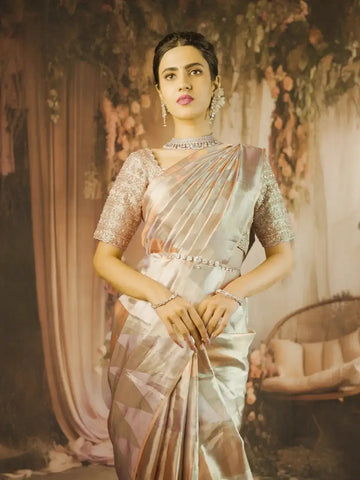
Choosing the Ideal Bridal Saree: Fabrics, Patterns, and Draping Styles
The bridal saree is not just a piece of clothing—it is the heart of a bride’s wedding look. In Indian culture, sarees symbolize tradition, heritage, and a deep sense of celebration. Every fold and drape tells a story, and each region of India has its own iconic bridal saree, from the grandeur of Kanchipuram silk sarees to the artistry of Banarasi weaves.
At Diadem, Chennai’s premium ethnic wear destination, brides can explore a curated range of bridal sarees, each crafted to celebrate individuality while preserving tradition. Whether you envision yourself in a rich silk drape for a temple wedding or a lightweight designer saree for a modern reception, your dream look starts with the right choice.
Why the Right Bridal Saree Matters
Selecting the right saree is more than a fashion decision—it sets the tone for your wedding look and ensures confidence throughout the day. Here’s why your choice matters:
-
Timeless Symbolism – A bridal saree often becomes an heirloom, passed down through generations.
-
Perfect Balance of Style and Comfort – Weddings are long, and the right fabric helps you stay comfortable while looking regal.
-
A Reflection of Identity – Sarees showcase personal style, culture, and regional traditions.
That’s why investing in a saree from a trusted brand like Diadem’s Wedding Saree Collection ensures that your attire will stand out not just on your big day but in cherished photographs for years to come.

Fabrics That Define Bridal Elegance
1. Kanchipuram Silk Sarees – Tamil Nadu’s Treasure
No bridal trousseau is complete without a Kanchipuram silk saree. Handwoven in Tamil Nadu, these sarees are known for their lustrous finish, temple borders, and traditional motifs like peacocks, elephants, and flowers. Their rich zari work makes them the go-to choice for South Indian weddings.
-
Ideal for: Traditional temple weddings.
-
Styling tip: Pair with gold jewelry and a contrast blouse for maximum effect.
2. Banarasi Sarees – The North Indian Classic
Hailing from Varanasi, Banarasi sarees are woven with intricate brocade and Mughal-inspired designs. They exude elegance and are perfect for brides seeking a royal yet sophisticated look.
Browse designer sarees at Diadem for Banarasi-inspired creations that combine heritage with modern cuts.
3. Georgette & Chiffon Sarees – Modern Comfort
For brides who want to move freely without the heaviness of silk, georgette and chiffon are ideal. These fabrics drape beautifully, often embellished with sequins, beads, or embroidery, making them popular for receptions.
Discover lightweight party wear sarees at Diadem that balance comfort with glamour.
4. Linen & Cotton Sarees – Graceful Minimalism
While unconventional, cotton and linen sarees are perfect for daytime ceremonies such as haldi or mehendi. Their breathable fabric allows comfort while maintaining elegance.
Minimalist brides often prefer festive sarees in cotton or linen to keep rituals simple yet stylish.

Regional Bridal Sarees Across India
Every state has a signature bridal saree tradition:
-
Kerala Kasavu Saree – Known for its white and gold palette, perfect for daytime weddings.
-
Mekhela Chador (Assam) – Elegant, handwoven in silk with natural motifs.
-
Patola Sarees (Gujarat) – Double ikat technique with vibrant, geometric designs.
-
Paithani Sarees (Maharashtra) – Characterized by peacock borders and handwoven artistry.
Diadem curates designs inspired by these traditions, making its bridal saree collection a one-stop destination for diverse bridal styles.
Patterns and Motifs to Look For
-
Zari Work & Borders – Classic for silk sarees.
-
Temple Motifs – Symbolic, cultural, and divine.
-
Paisleys & Florals – Feminine and timeless.
-
Geometric & Modern Embroidery – Perfect for fusion brides.
At Diadem, every saree is crafted with attention to detail, ensuring motifs complement the bride’s personality and jewelry.
Draping Styles to Elevate Your Look
The magic of a saree lies in how it is draped. Here are some popular bridal drapes:
-
Nivi Drape – The most versatile style, easy to carry.
-
Bengali Drape – Wide pleats and a pallu draped over both shoulders.
-
Maharashtrian Nauvari – Traditional and powerful, resembling a dhoti.
-
Modern Belted Drape – A trendy style where the pallu is secured with a belt.
Pair your saree with unique designer blouses to highlight draping styles creatively.
Expert Tips for Choosing the Perfect Bridal Saree
-
Match the saree to your venue and theme—silk suits traditional temple weddings, while georgette works for receptions.
-
Consider longevity: choose a saree you’ll want to wear again for anniversaries and festivals.
-
Balance your saree with jewelry: heavy zari needs subtle accessories, while minimal sarees can handle bold pieces.
-
Always rehearse draping styles before the wedding to avoid discomfort.
Shopping at Diadem’s bridal saree store in Chennai ensures you have expert guidance on styling and fabric care.
FAQs on Bridal Sarees
Q. What is the most popular fabric for bridal sarees?
Silk, especially Kanchipuram Pattu sarees, is considered the gold standard.
Q. Can modern brides wear lightweight sarees?
Yes, chiffon and georgette sarees are popular for receptions and modern wedding themes.
Q. How do I preserve my bridal saree?
Dry clean after use, store in a muslin bag, and avoid direct sunlight to protect zari work.
Q. Should I buy more than one saree for wedding events?
Most brides choose at least three—one for the main wedding, one for the reception, and one for rituals.
Conclusion
A bridal saree is more than attire—it’s an heirloom, a symbol of heritage, and a reflection of the bride’s personality. From luxurious Kanchipuram silks to lightweight designer sarees, each choice tells a story of love, culture, and style. By selecting the right fabric, pattern, and draping style, brides can create a look that is both timeless and unforgettable.
Explore your dream ensemble at Diadem’s Bridal Saree Collection and step into your wedding day with confidence, grace, and unmatched elegance.

